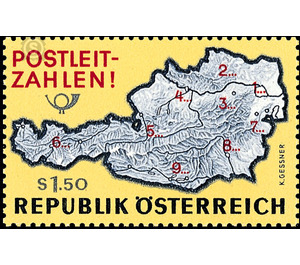introduction - Austria / II. Republic of Austria 1966 - 1.50 Shilling
Theme: Expeditions & voyages
| Country | Austria / II. Republic of Austria |
| Issue Date | 1966 |
| Face Value | 1.50 |
| Color | multi-colored yellow |
| Printing Type | Photogravure |
| Stamp Type | Commemorative |
| Item Type | Stamp |
| Chronological Issue Number | 544 |
| Chronological Chapter | OOS-OE2 |
| SID | 205431 |
| In 106 Wishlists | |
On 1 January 1966 postal codes were introduced in Austria. Austria followed the example of other European countries. The purpose of introducing postal codes was to create the conditions for rationalization of the mail service, in particular through the use of machinery. This should enable Swiss Post to cope with the ever-increasing flood of mail. Each post office received its own, always four-digit, consisting of Arabic numerals postal code. Every significance of the postal code created according to traffic-geographical aspects expresses a so-called lead unit. Austria is divided into new key zones, the borders of which essentially coincide with the borders of the federal states. These lead units are getting smaller and smaller, until finally the one-place is the destination post office. The Austrian postal code network, which is much more closely meshed with foreign models, makes it possible to distribute the many postal items for larger cities to the individual delivery post offices at an earlier stage of transport. The brand image shows a tinted background of a map of Austria, on which the nine leading zones are drawn.


